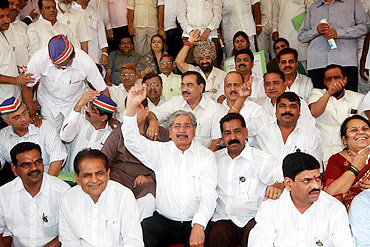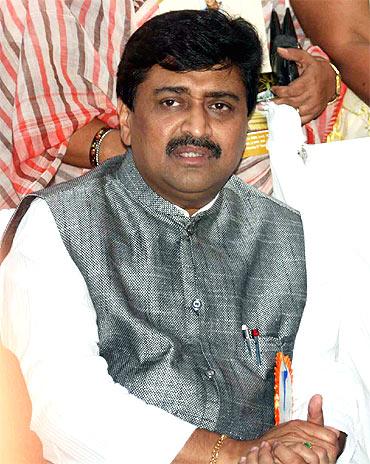 | « Back to article | Print this article |
Explained: Why two states want Belgaum
Situated near the foothills of the Sahyadri mountain range, a mineral rich Belgaum has been a bone of contention between two states -- Maharashtra and Karnataka -- each staking claim for its ownership.
Now, the central government has stoked the fire by backing the Bharatiya Janata Party-ruled Karnataka's claim. It filed an affidavit in the Supreme Court Centre in a case filed by Maharashtra in 2004 under the States Reorganisation Act 1956 challenging the inclusion of 865 Marathi-speaking villages in Belgaum, Karwar, Gulbarga and Bidar in Karnataka.
The Centre stating that language was never the sole determinant behind the reorganisation of states and that Maharashtra had no claim over Belgaum. As protests echo on either sides of the border, rediff.com gives you an insight into the Belgaum ownership issue. Click on NEXT to read further...
Why two states want Belgaum
What is the issue all about?
The erstwhile state of Mysore was joined with parts of Bombay (now Mumbai), Hyderabad, Madras (now Chennai) and Coorg to form Karnataka five decades ago under the States Reorganisation Act, 1956. During this process, certain Marathi-speaking areas were also merged into it, which became a cause of dispute between Maharashtra and Karnataka.
In 1957, the then government of Bombay requested the zonal council to recommend re-demarcation of the boundaries on uniform principles, but this was not formally considered.
With attempts to reach an amicable solution failing, the government of India had to intervene. But nothing happened until 1966, when Senapati Bapat, a freedom fighter, and three other Maharashtrian leaders went on a fast unto death demanding the resolution of the dispute.
In October 1966, the government of India appointed the third Chief Justice, Mehr Chand Mahajan, to make recommendations to solve the dispute.
Why two states want Belgaum
While the Maharashtra government had made a representation to the Centre to merge 865 villages and towns (comprising 3,000 square miles or 7,770 sq km) from Karnataka, which had a relative majority of Marathi-speaking population, into Maharashtra. The commission, which submitted its report in August 1967, recommended that 264 villages (covering an area of 656.3 sq km) be transferred.
Of the 516 villages claimed by Karnataka, the commission recommended the transfer of 247 from Maharashtra. Crucially, the Mahajan Commission did not recommend the transfer of Belgaum to Maharashtra, on 'administrative grounds' and holding that there was 'lack of linguistic gravity'.
While initially Karnataka was not keen on a commission -- insisting instead on the status quo -- at the end of the exercise it was Maharashtra that refused to accept the Mahajan Commission report, wanting Parliament to reconsider the recommendations.
In March 2004, the Congress-Nationalist Congress Party government of Sushilkumar Shinde in Maharashtra filed a suit under Article 131 of the Constitution in the Supreme Court on the question of the transfer of Belgaum to Maharashtra, where the matter currently lies.
Why two states want Belgaum
Replying to Maharashtra's 2004 affidavit and its application filed in 2009, the Centre said that just because many people in the border districts talk Marathi, it could not be a reason for the areas to be appended to Maharashtra.
Maharashtra's affidavit and its application claimed jurisdiction over 814 villages in Belgaum, Karwar, Bidar and Gulbarga districts in Karnataka that it said had majority Marathi-speaking people.
"The transfer of certain areas to then Mysore (now Karnataka) was neither arbitrary nor wrong as claimed by Maharashtra. The language of the people has been one of the criteria, but not the sole criterion for inclusion of any area in a state," the Centre said.
"The States Reorganisation Commission had a balanced approach to the issue and was not arbitrary. Both Parliament and the Union government had considered all the relevant factors while considering the State Reorganisation Bill, 1956, and the Bombay Reorganisation Bill, 1960, and decided the village, taluka, municipal areas towns etc which are to be included in the concerned states," it added.
Why two states want Belgaum
How has Maharashtra reacted to the Centre's response to its affidavit?
Maharashtra Chief Minister Ashok Chavan has demanded that the Centre declare Marathi-speaking villages in Karnataka, including Belgaum, as a Union Territory till a court decision was arrived at. The opposition Shiv Sena backed the demand.
"The neighbouring state is in a hurry to rename the disputed villages and Belgaum city and has also said that the legislature session would be held in the city. We demand that the Karnataka government maintain status quo till the issue is resolved in the Supreme Court. Our fight for 865 villages will continue," Chavan said.
An all-party delegation met Prime Minister Manmohan singh on July 14 and submitted a memorandum urging the Centre to review its stand.
"Good educational institutions have been destroyed. Marathi medium schools were deliberately closed down, while in Mumbai and elsewhere in Maharashtra, we try to encourage Kannada medium schools," Chavan alleged.
Why two states want Belgaum
Meanwhile, the Maharashtra Ekikaran Samiti, an all-party organisation fighting for merger of Marathi-speaking areas in Karnataka with Maharashtra, has been holding demonstrations in Kolhapur and areas bordering Belgaum.
"Hundreds have sacrificed their lives in the fight for merger of Marathi-speaking areas with Maharashtra but justice has not been done," the Samiti said in a statement, adding: "When Shivraj Patil was the Union Home minister, it was agreed that the Centre would remain neutral on the border row why does the Centre need over two-and-a-half years to submit a four-line affidavit?"
Shiv Sena executive president Uddhav Thackeray said: "Nehru did not want to give Mumbai to Maharashtra when the state was formed. But now there is no C D Deshmukh (Union finance minister from 1950-56) in the Cabinet... for the present-day (Maharashtrian) ministers, cricket is more important," he said, without naming Sharad Pawar.
Why two states want Belgaum
Karnataka Chief Minister B S Yeddyurappa has charged the Maharashtra government with raking up the Belgaum boundary issue to "cover up" political differences between the ruling alliance partners, the Congress and the Nationalist Congress Party.
"The Mahajan Commission report is final," he said, a day after Chavan asked the Centre to declare 865 Marathi speaking villages in Karnataka as a Union Territory."It (the boundary dispute) is a closed chapter," he said, pointing out that the Mahajan Commission was appointed after both Karnataka and Maharashtra gave their approval.
Karnataka had accepted its report, Yeddyurappa said, adding the Centre had also filed an affidavit declaring that those villages are part of Karnataka.
He termed as "unfortunate" the raking up of the boundary issue by the Maharashtra Ekikaran Samiti and urged the Maharashtra government not to entertain its 'baseless demand'.
Why two states want Belgaum
There will be more courtroom drama...
A bench of Justices J M Panchal and A K Patnaik has granted four weeks to Maharashtra to amend its original suit filed on March 29, 2004. The court said Karnataka government will have to file its response within eight weeks after the amended suit is filed.
Senior advocates Harish Salve and Vinod Bobde, appearing for Maharashtra, submitted that some basic and settled principles like wishes of the people and linguistic criteria were not followed when these districts were ceded to Karnataka.
In the application filed through its advocate Shivaji Jadhav for amending the lawsuit, Maharashtra submitted that all these factors were considered for demarcation of boundaries between Tamil Nadu and Andhra Pradesh, Punjab and Haryana and Maharashtra and Gujarat.
Senior advocate Fali Nariman, appearing for the Karnataka government, opposed the application for amending the six-year-old lawsuit. The Maharashtra government had earlier contended that the principle laid down for reorganisation of states under Article 3 of the Constitution has been violated.







